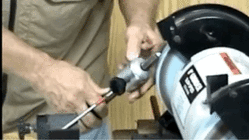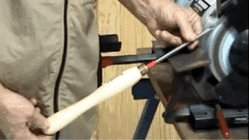I fear this discussion is rounding the last turn and heading for the finish line, and if it still has momentum, into circles it will go. As I mentioned in an earlier message, this is all hypothesizing until someone breaks out the proper scientific instruments and actually documents facts.
Although there is one variable that I don't think has been discussed- pressure loads on the edge itself. At the grinder (or whatever metal removal instrument is used), we are dressing one facet (bevel) to meet another at a zero-radius line. We aren't "cutting" the grinding wheel, it's cutting the metal tool. Then we step back to the wood and do something completely different- we rub the bevel on the wood (in the exact same orientation we rub the bevel on the grinding wheel), but then we tilt/lift the tool a fraction of a degree to catch the resulting zero-radius line (edge) into the wood fibers and pair them away.
At this point more scientific instrumentation is needed, because even though the wood is easily yielding to the harder metal edge, the wood is also at war with the invading edge (the bevel we ground at the wheel isn't causing harm to the wood, but the friction between the two is creating heat, and that heat has to disperse along all of the metal, even the edge), pounding the daylights out of that zero-radius line with... several thousand(?) psi of force (and some amount of heat), maybe removing a few metal particles at the microscopic level, but just as much, if not more, rolling over and blunting that zero-radius line (think the hook on a scraper) to become a radius- we no longer have a 2-dimensional line as a meeting point of two facets (bevels), and we've lost the sharp edge. The more acute the angle of the bevels (skew chisel vs. traditional bowl gouge), the easier it blunts. Back to the grinder we go to grind away that rolled-over edge.
Theoretically, if you want to preserve tool steel, we should be using a burnisher more often, applying several thousand psi of pressure (which takes very little effort by hand) to simply re-align that rolled edge back into a zero-radius line. This probably isn't as practical with a gouge as it is with a scraper (or a turkey carving knife), so we grind the tool instead for a few seconds, then get back to work.


